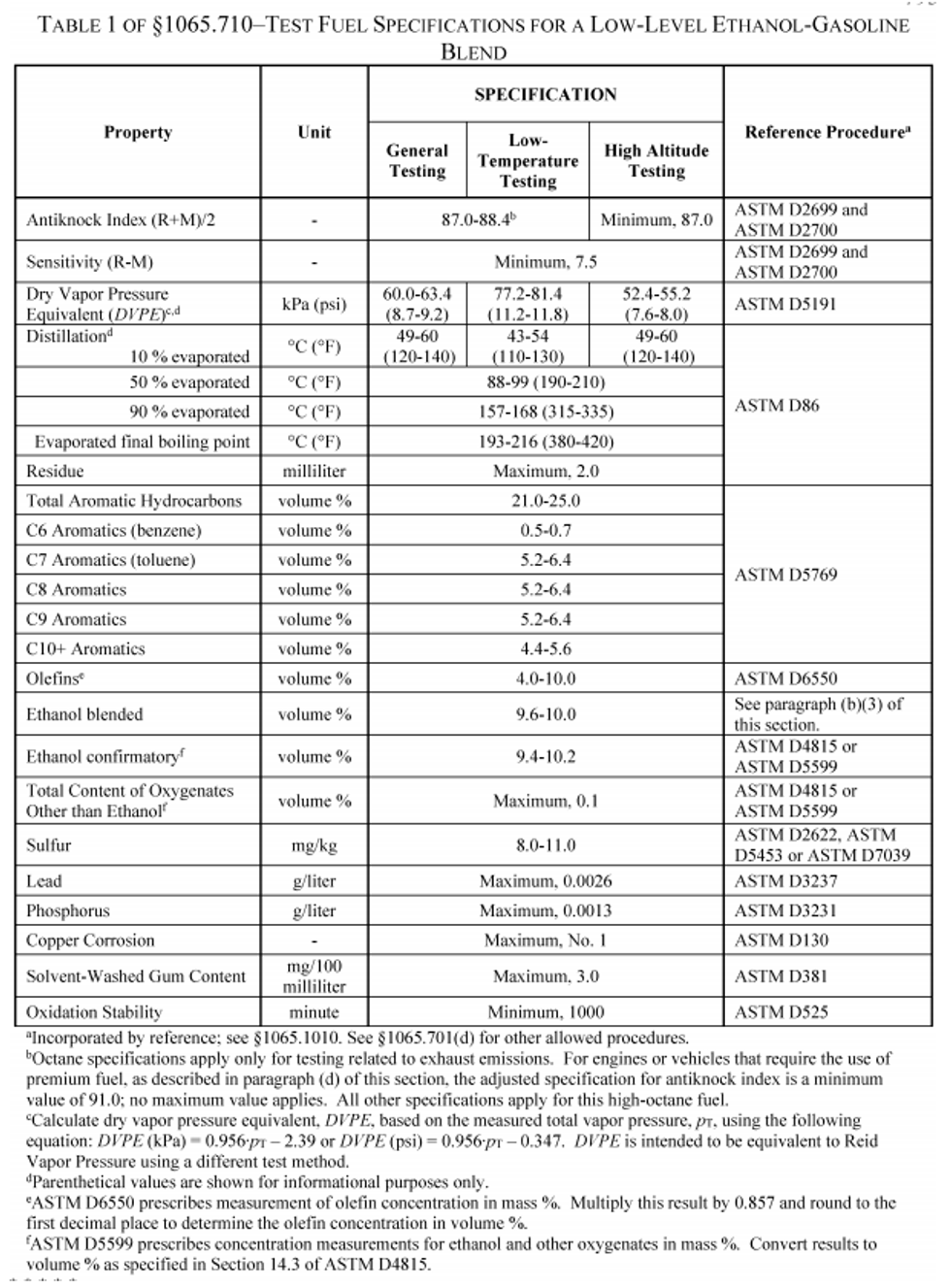...
(a) This section specifies test fuel properties for gasoline with ethanol (low-level blend only) and for gasoline without ethanol. Note that the “fuel type” for the fuels specified in paragraphs (b) and (c) of this section is considered to be gasoline. In contrast, fuels with higher ethanol concentrations, such as fuel containing 82 percent ethanol, are considered to be ethanol fuels rather than gasoline. We specify some test fuel parameters that apply uniquely for low-temperature testing and for testing at altitudes above 1,219 m. For all other testing, use the test fuel parameters specified for general testing. Unless the standard-setting part specifies otherwise, use the fuel specified in paragraph (c) of this section for general testing.
(b) The following specifications apply for a blended gasoline test fuel that has nominally 10% ethanol (commonly called E10 test fuel):
(1) Prepare the blended test fuel from typical refinery gasoline blending components. You may not use pure compounds, except as follows:
(i) You may use neat ethanol as a blendstock.
(ii) You may adjust the test fuel's vapor pressure by adding butane.
(iii) You may adjust the test fuel's benzene content by adding benzene.
(iv) You may adjust the test fuel's sulfur content by adding sulfur compounds that are representative of those found with in-use fuels.
(2) Table 1 of this section identifies limit values consistent with the units in the reference procedure for each fuel property. These values are generally specified in international units. Values presented in parentheses are for information only. Table 1 follows:

(3) The ethanol-blended specification in Table 1 of this section is based on the volume % ethanol content of the fuel as determined during blending by the fuel supplier and as stated by the supplier at the time of fuel delivery. Use good engineering judgment to determine the volume % of ethanol based on the volume of each blendstock. We recommend using a flow-based or gravimetric procedure that has an accuracy and repeatability of ±0.1%.
(c) The specifications of this paragraph (c) apply for testing with neat gasoline. This is sometimes called indolene or E0 test fuel. Gasoline for testing must have octane values that represent commercially available fuels for the appropriate application. Test fuel specifications apply as follows:
| Property | Unit | Specification | Reference procedure 1 | |
|---|---|---|---|---|
| General testing | Low-temperature
testing | |||
| Distillation Range: | ||||
| Evaporated initial boiling point | °C | 24-35 2 | 24-36 | ASTM D86. |
| 10% evaporated | °C | 49-57 | 37-48 | |
| 50% evaporated | °C | 93-110 | 82-101 | |
| 90% evaporated | °C | 149-163 | 158-174 | |
| Evaporated final boiling point | °C | Maximum, 213 | Maximum, 212 | |
| Total Aromatic Hydrocarbons | volume % | Maximum, 35 | Maximum, 30.4 | ASTM D1319 or ASTM D5769. |
| Olefins c | volume % | Maximum, 10 | Maximum, 17.5 | ASTM D1319 or ASTM D6550. |
| Lead | g/liter | Maximum, 0.013 | Maximum, 0.013 | ASTM D3237. |
| Phosphorous | g/liter | Maximum, 0.0013 | Maximum, 0.005 | ASTM D3231. |
| Total sulfur | mg/kg | Maximum, 80 | Maximum, 80 | ASTM D2622. |
| Dry vapor pressure equivalent d | kPa | 60.0-63.4 | 77.2-81.4 | ASTM D5191. |
| a Incorporated by reference; see §1065.1010. See §1065.701(d) for other allowed procedures. | ||||
| b For testing at altitudes above 1219 m, the specified initial boiling point range is (23.9 to 40.6) °C and the specified volatility range is (52.0 to 55.2) kPa. | ||||
| c ASTM D6550 prescribes measurement of olefin concentration in mass %. Multiply this result by 0.857 and round to the first decimal place to determine the olefin concentration in volume %. | ||||
| d Calculate dry vapor pressure equivalent, DVPE, based on the measured total vapor pressure, pT, in kPa using the following equation: DVPE(kPa) = 0.956·p − 2.39 or DVPE(psi) = 0.956·p − 0.347. DVPE is intended to be equivalent to Reid Vapor Pressure using a different test method. | ||||
| e For testing unrelated to evaporative emissions, the specified range is (55.2 to 63.4) kPa. | ||||
(d) Use the high-octane gasoline specified in paragraph (b) of this section only for engines or vehicles for which the manufacturer conditions the warranty on the use of premium gasoline.
[79 FR 23809, Apr. 28, 2014, as amended at 80 FR 9119, Feb. 19, 2015; 86 FR 34571, Jun. 29, 2021]
